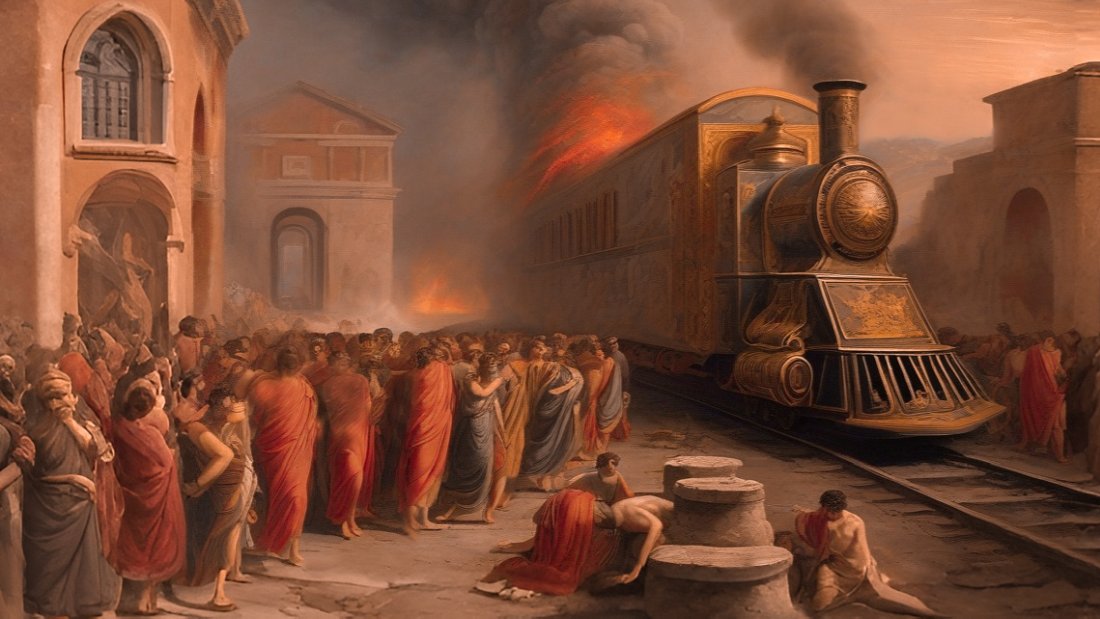Alright, buckle up railway fans because we’re about to embark on a thrilling journey of pre-industrial rail travel! Forget your high-speed bullet trains and reclining seats – and that means a focus upon Railways 2000! We’re going back to a time when “comfort” meant not getting splinters in your, shall we say, posterior. Italians invented helicopters and submarines more than 500 years ago but these were a bit too late for we’re talking about what must be another 1500 years earlier – the Roman Empire, circa AD 79. Just before that charming little volcanic incident in Pompeii.
Now, before you picture toga-clad Romans sipping wine while zipping across the countryside on a sleek locomotive, let’s adjust your expectations. Think less “Orient Express” and more “glorified quarry cart.” Because, let’s be honest, the Romans were fantastic engineers, but their priorities were more along the lines of conquering new territories and building impressive bathhouses than developing efficient public transportation.
So, where does this whole “pre-railway” thing come in? Well, it starts with rocks. Big, heavy rocks. Specifically, the kind the Romans loved to use for building their incredibly durable roads, aqueducts, and, of course, those aforementioned bathhouses. Transporting these massive stones any significant distance was, shall we say, a bit of a logistical nightmare. Envision legions of slaves (because, you know, they had plenty of those) straining and sweating while dragging enormous blocks on crude sleds. Efficient? Hardly. Back-breaking? Absolutely.
Enterprising Romans, being the resourceful bunch they were, started to experiment with ways to reduce the friction. And that’s where our proto-railways appear. These were essentially grooves carved into stone roads, designed to guide wheeled vehicles specifically designed for the job. Imagine rutted tracks, maybe a meter or so apart, carefully chiseled into the paving stones. These were especially prominent near quarries and construction sites. Think of them as the ancient Roman equivalent of a train yard, but instead of the rhythmic “clackety-clack,” you’d hear the agonizing groans of oxen and the crack of whips. Ah, progress!
The vehicles themselves weren’t exactly luxurious. We’re talking sturdy wooden carts, often with iron-rimmed wheels, perfectly sized to fit snugly within the grooves. This allowed for heavier loads to be transported with less effort. Less effort for the Romans, that is. The oxen and slaves were probably still having a pretty rough day.
Now, before you get too excited about imagining a Roman commuting to work via rail, let’s clarify a few things. These weren’t exactly “passenger lines.” You weren’t likely to find a timetable or a station master. These “railways” were strictly for hauling materials, primarily stone, over relatively short distances. Think of them as the Roman equivalent of a mining cart system, but on a larger, more public scale.

Romans attempt to escape as the volcano engulfs Pompeii. Scene showing how rail transport could have been 2000 years ago. Leonardo – where were you in 79AD?
And the speed? Well, let’s just say you wouldn’t want to be late for an appointment. We’re talking a leisurely stroll for the oxen, maybe a brisk walk for a particularly motivated slave driver. Definitely not breaking any speed records. The ride quality? Let’s just say the term “suspension” hadn’t been invented yet. Prepare for bumps, jolts, and the distinct possibility of a wheel popping out if you hit a particularly rough spot.
But here’s the really fascinating part. These proto-railways predate the Industrial Revolution by, oh, about 1750 years. They represent a remarkably early attempt at improving transportation efficiency. They demonstrate the Romans’ ingenuity and their pragmatic approach to solving logistical problems. They were thinking outside the (stone) box!
Of course, the whole system wasn’t exactly widespread. It was primarily concentrated in areas where there was a high demand for stone and a need for efficient transport. But the evidence is there, etched in the very stones of Roman roads. Scars of a forgotten era of pre-industrial rail travel.
And then, of course, there’s Pompeii. The bustling Roman city, frozen in time by the eruption of Mount Vesuvius. While we don’t have evidence of an extensive pre-railway system within Pompeii itself, the city provides a snapshot of the world in which these early “railways” existed. A world of impressive engineering, brutal labour practices, and a constant need for building materials. A world that was about to be dramatically reshaped by a cataclysmic event.
So, the next time you’re complaining about your delayed train or the lack of legroom the seats have, remember the ancient Romans and their resourceful, albeit rudimentary, attempts at rail travel. At least you’re not being whipped by an overseer while hauling a ton of granite on a bumpy stone track. And you’re probably not about to be buried under several feet of volcanic ash. Its perspective, perspective! Plus a little appreciation for the evolution of transportation. From glorified quarry carts to high-speed trains, we’ve come a long way. Despite the apparent progression from Rail 2000 to what is in this year of 2025 called Railway 200, if you’ll excuse me I’m going to go book a vacation and try to forget about the image of those poor overworked oxen.
